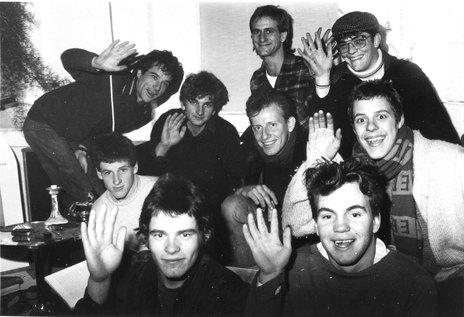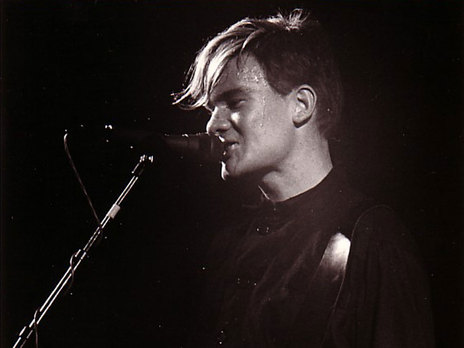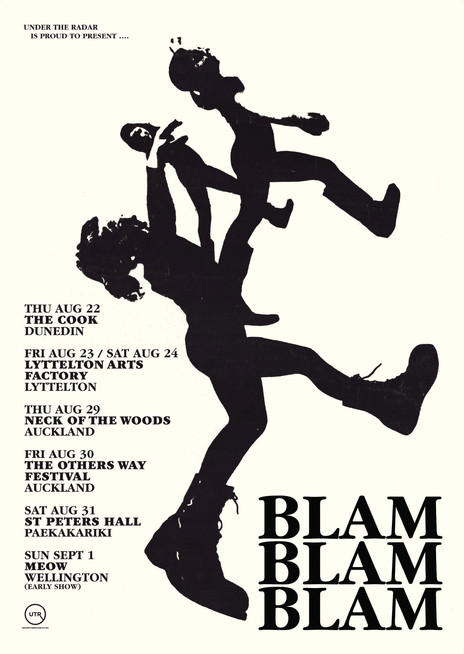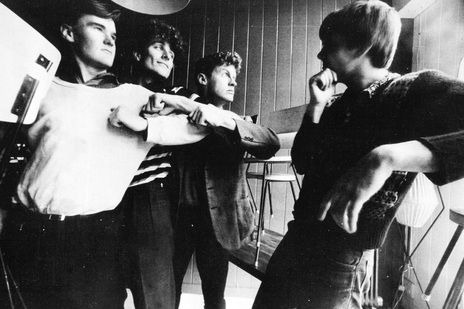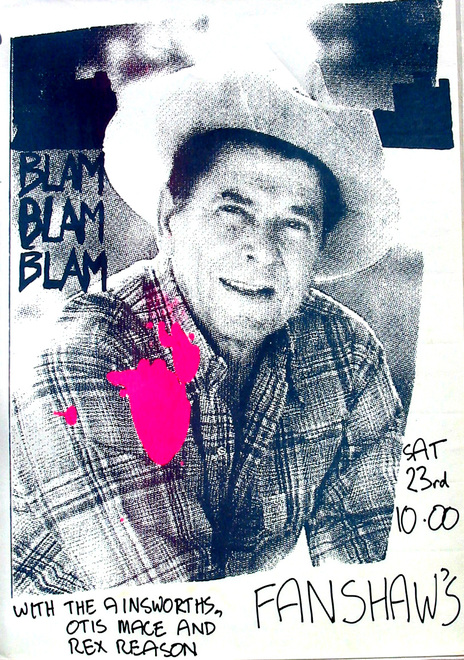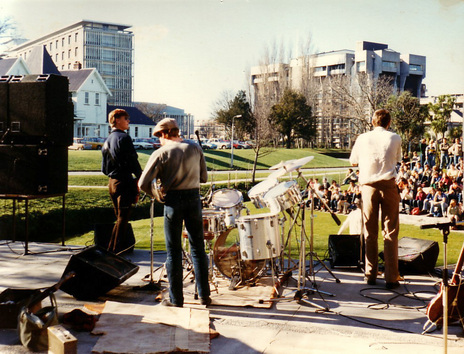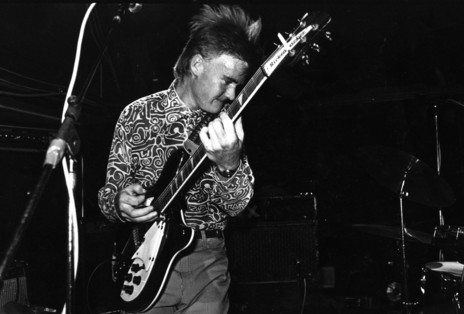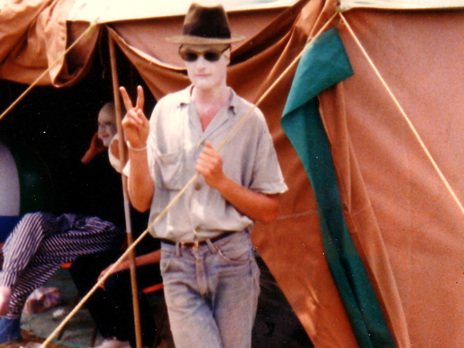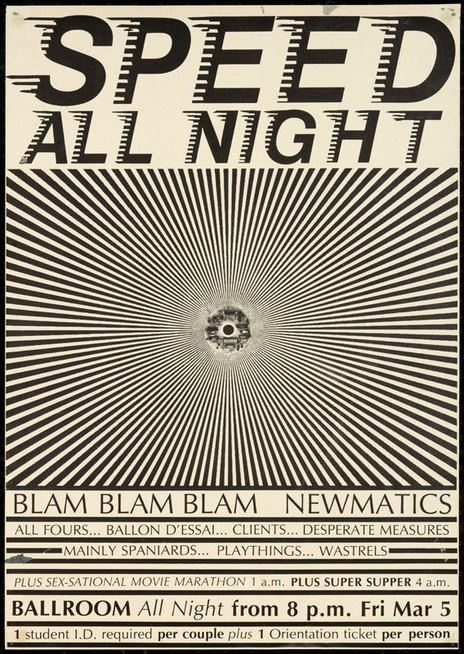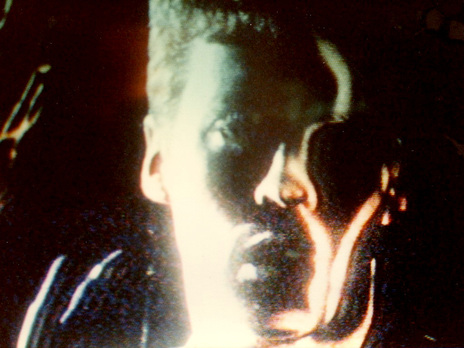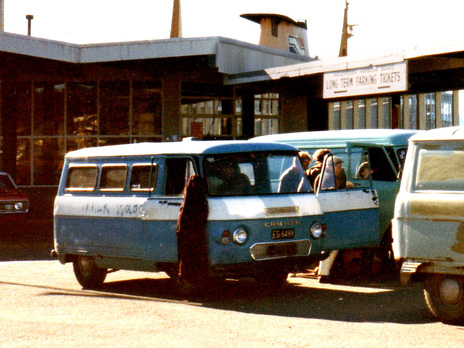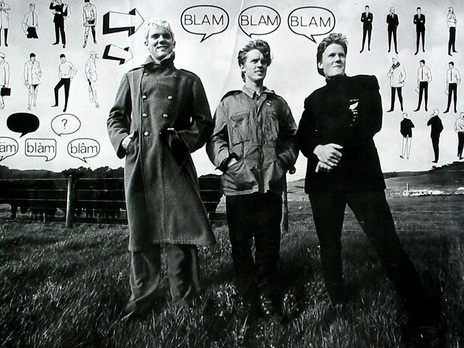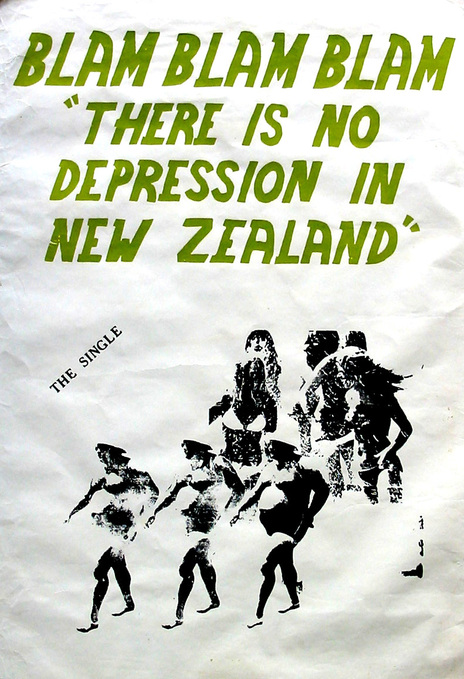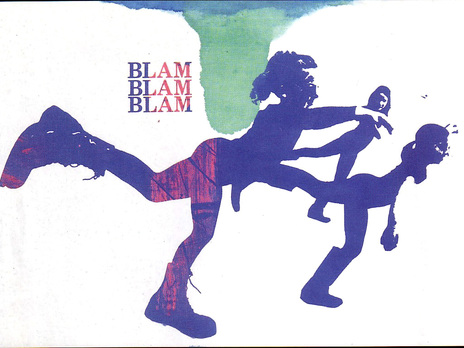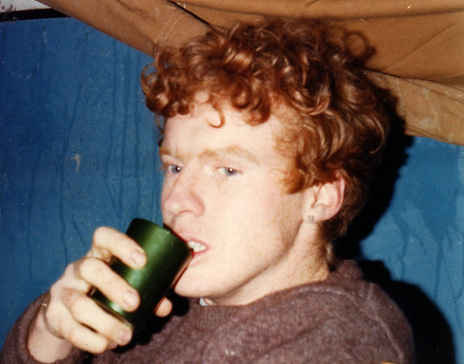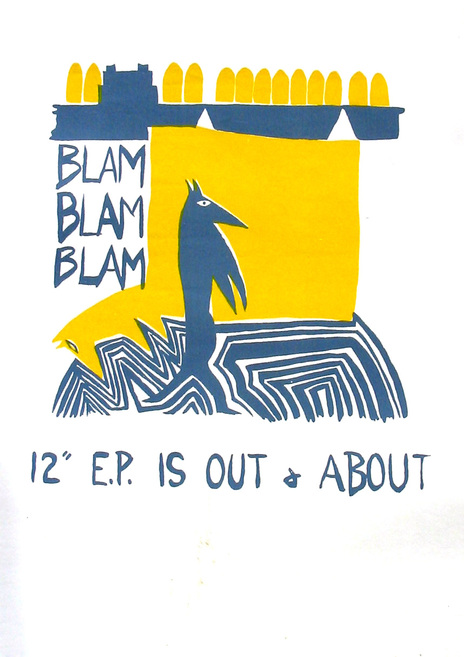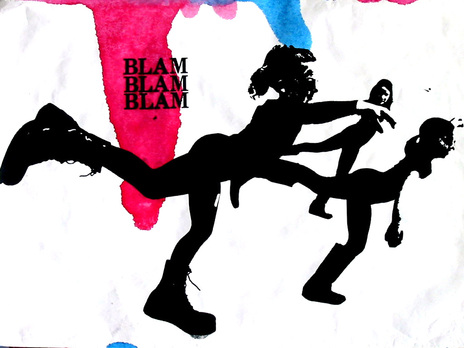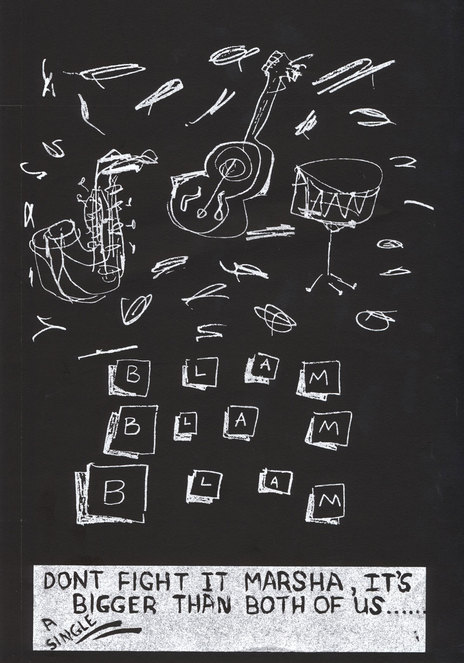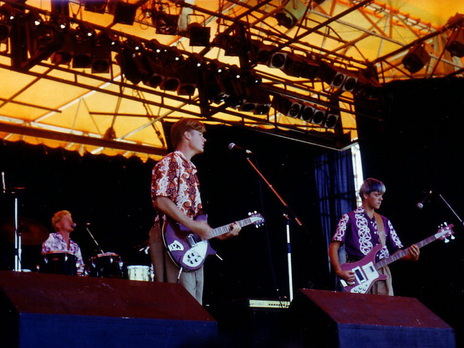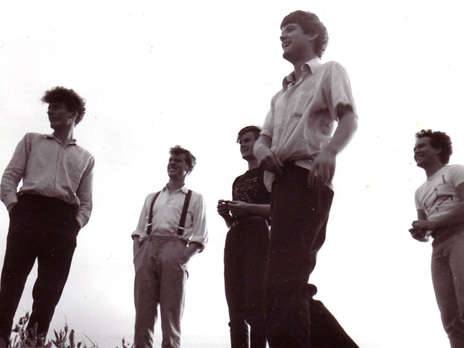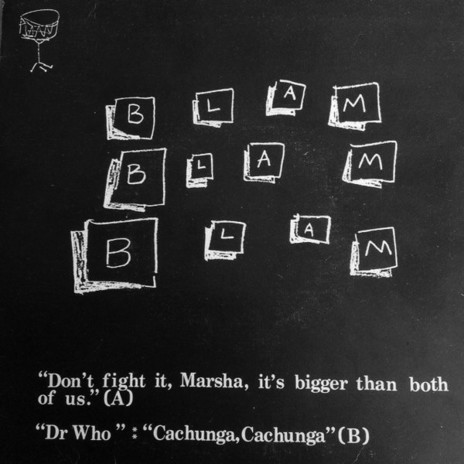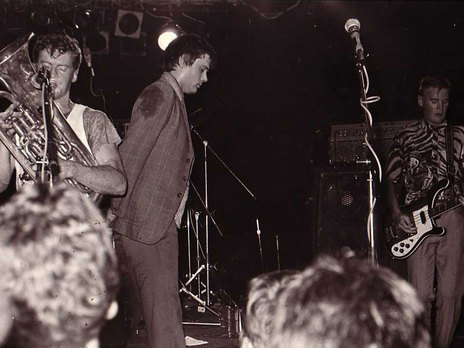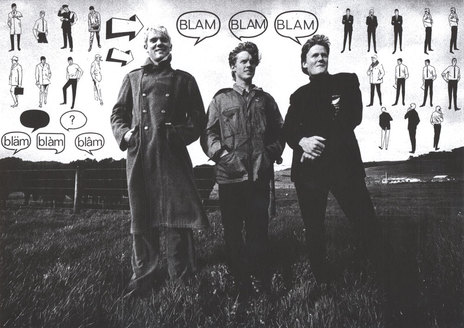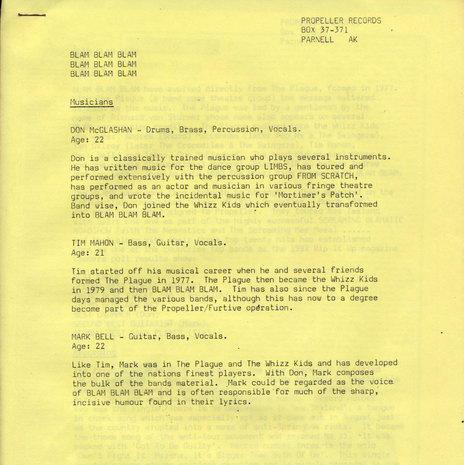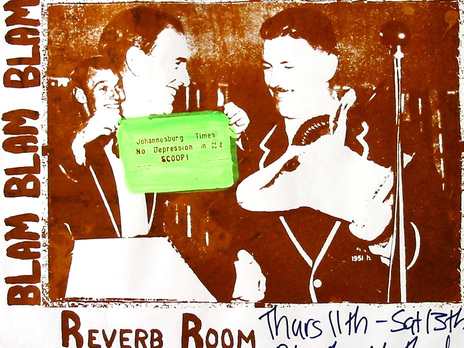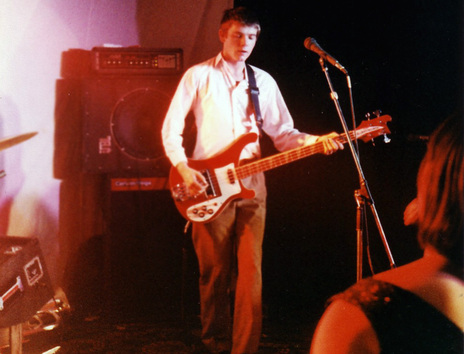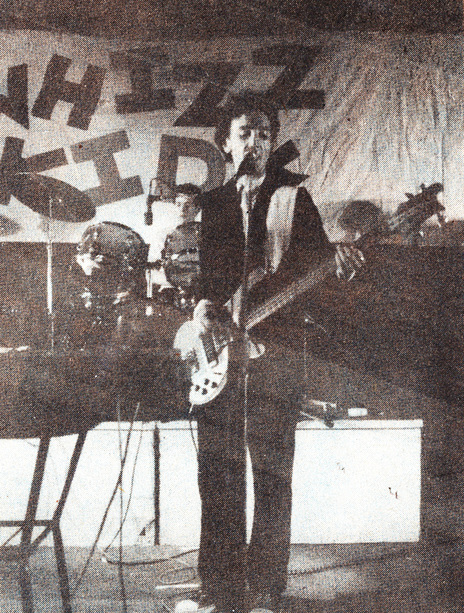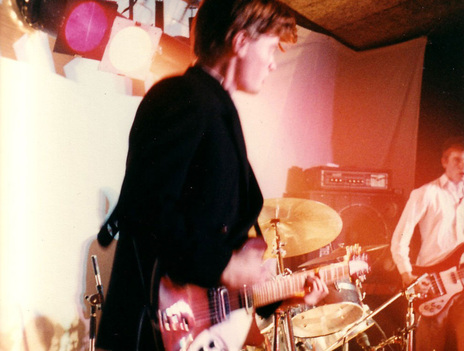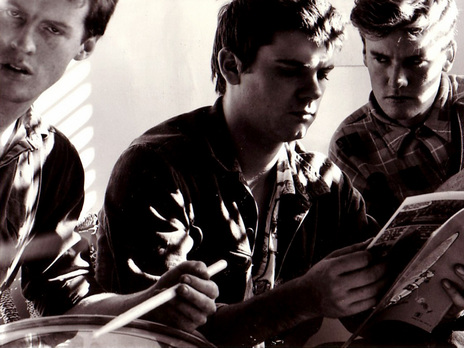In one telling set-piece, Blam Blam Blam’s Mark Bell (guitar) and Tim Mahon (bass) dance in Vegemite and Marmite costumes, mimicking a shallow, constricted sense of national identity that allows difference only through minor, non-political traits such as taste in yeast spread.
Drummer-singer Don McGlashan wrote the music, and described ‘No Depression’ as a song about “how New Zealanders try to build myths around themselves.”
This is the version of the early 1980s that will come to dominate in the popular mind. That of a highly political time where an overdue re-examination of New Zealand’s self and place heralded a period of societal change. A rupture marked starkly by violent nationwide protests over a racially exclusive South African rugby team touring NZ in mid-1981.
Over time, ‘No Depression’ would become a song about the Springbok tour and an alternative anthem, despite Richard Von Sturmer’s lyrics being written well in advance of the event. Inside Information, a street performance troupe featuring McGlashan, Von Sturmer, John Schmidt, Richard Lello (Otis Mace) and Charlotte Wrightson had already used the song in a series of Auckland shows at XS Café and Rumba Bar in November 1980 and on the West Coast and in Wellington in December.
A second, less-seen video presents a montage of group and fan photographs from the vibrant Auckland live scene of 1980 and 1981. Split Enz, Mi-Sex, The Clean, Toy Love, Pop Mechanix, Beat Rhythm Fashion, The Screaming Meemees, The Crocodiles and The Swingers are all there – as are shots of punks, rockabilly rebels and the entrance to Mainstreet Cabaret, a key inner city venue.
Between 1980 and 1982, the nation’s live venues were afire with the fresh sounds and dozens of New Zealand singles made the Top 50.
Therein lies another 1981. A year where New Zealand rock and pop music, buoyed by the post-punk tumult of the late 1970s and early 1980s gave birth to the widest outbreak of rock and roll creativity since the second half of the 1960s. Between 1980 and 1982, the nation’s live venues were afire with the fresh sounds and dozens of New Zealand singles made the Top 50, many of them from the rising new wave of post-punk acts.
Musically challenging local singles were already in the charts when Blam Blam Blam formed. The Swingers in particular would be highly influential. Blam Blam Blam and The Features both use Phil Judd’s wordless vocalisms and echoed, de-centred guitar. It’s no surprise that the second video begins and ends with images of Phil Judd.
The innovative local releases were in good company. Britain was pumping out provocative sounds at a mad rate, filling New Zealand’s record stores and charts with a bewildering array of music. In 1980 alone, the charts featured mod rock from The Jam, rap from Sugarhill Gang and off-centre sound from XTC and The Cure alongside modern takes on reggae and ska from The Specials, The Police, UB40 and The Clash. PIL, Magazine, OMD, Gang of Four and Talking Heads made good showings in the album chart.
The following year saw even more adventurous and challenging music. In August, the month that ‘No Depression’ peaked, Joy Division and The Fall climbed the NZ pop charts to heights not reached in their homeland, and Blam Blam Blam label mates The Screaming Meemees gave New Zealand’s new wave its first No.1 with ‘See Me Go’.
The establishment of a robust national touring circuit from 1980 on and the rise of new Auckland-based independent label Propeller Records meant Blam Blam Blam were well placed to take full advantage of the creative turmoil.
There’s no doubt that these were political times, but that is only part of the information and motivation fans took onboard. It doesn’t preclude the usual activity of young lives. Focusing on one over the other meant the joy and individual agency of growing up in exciting times was deflated and almost lost beneath a furrowed political brow.
The Blam Blam Blam story properly began in 1977 with The Plague, an Auckland punk-theatre group giving expression to the ideas of poet, performer and filmmaker Richard Von Sturmer (not to be confused with mid-1960s Rotorua band The Plague). Auckland’s Plague were onstage at 1979’s Nambassa Festival and in the movie of the same name – Richard Von Sturmer, Sara Fort and Charlotte Wrightson – a bright body paint away from nature – up front of the musical core of Ian Gilroy, Tim Mahon, Andrew Snoid and Mark Bell.
They got around did The Plague, headlining in Auckland at Squeeze and State Theatre, and at Hamilton’s Hillcrest and Wellington’s Last Resort, but despite all that exposure, the only contemporary song available was ‘Panthers of Sound’ on Festival Music, the double-album Nambassa soundtrack.
The Plague captured four original songs – ‘Mystery No Mystery’, ‘Kiwi Keith’, ‘Seven Day Plan’ and ‘Voodoo TV’ – a spiky, opinionated clutch of agitprop with second wind punk heft – at Harlequin studios with Doug Rogers in Auckland in 1979. They wouldn’t be released until 2012.
When Ian Gilroy, Tim Mahon, Andrew Snoid and Mark Bell re-emerged with Kit Snoid as The Whizz Kids in November 1979, Von Sturmer’s influence was still strong. The new wave quartet toured the South Island and lower North Island in December 1979 and January 1980, bannered as The Plague inc. presents.
As one of the first of the new era’s groups to tour nationally, The Whizz Kids used the crème of New Zealand’s rising post-punk groups as support. In Christchurch, they had The Vauxhalls, Bill Direen’s Vacuum and The Gordons on first. In Wellington, it was The Steroids and Shoes This High. Auckland stumped up The Androidss and Sheerlux in April. By late May they had a new drummer, Don McGlashan of From Scratch, when they supported The Swingers at Mainstreet. All this on the back of well-received opening sets for Split Enz in February soon after Kit Snoid’s departure.
The Whizz Kids’ final Auckland show was supporting The Ramones at Logan Campbell Centre on July 21, 1980, before heading south in late July and August 1980 to Wellington’s Billy d’club for dates with LIFE and The Wallsockets.
That left only ‘Occupational Hazard’, a posthumous September 1980 single for Ripper Records shared with The Spelling Mistakes’ ‘Reena’. Neither track made any discernable impact. The two songs – ‘Noise Boys’ and ‘Factory’ – they recorded at Wellington’s EMI studios for television use are unreleased.
The three remaining Whizz Kids – the only ones turning up to practice, they joked – Don McGlashan (drums, vocals, euphonium) who joined after Ian Gilroy left for The Crocodiles and then The Swingers, Tim Mahon (bass) and Mark Bell (guitar), reconstituted as Blam Blam Blam in late 1980. Like so much of their early inspiration, they found their name in Richard Von Sturmer’s work.
The new trio ventured out to South Auckland in October 1980 for a series of street performances for Manukau City Council. Three songs, including ‘Second World’ and ‘Motivation’ were then captured at Harlequin studios. When Mark Bell’s offbeat ‘Motivation’ appeared in late February 1981 on Propeller Records’ era-defining Class of ’81 compilation, it stood out like an awkward child.
When Rip It Up Xtra caught them at the short-lived Reggae Club in Victoria Street East in mid-November 1980 with the Newmatics, the reggae/ska/soul group’s crowd decamped en masse before the Blams' set. Blam Blam Blam’s sound, while already “complex, rhythmic and danceable”, hadn’t found fuller favour just yet.
The road beckoned the already well-travelled trio again in late 1980. They saw 1981 in at Wellington’s Last Resort and Terminus after shows in Christchurch and on the South Island’s West Coast. Then it was north for the second Sweetwaters festival and Queen city gigs with frequent live partners The Screaming Meemees and The Newmatics.
Blam Blam Blam joined their Class of ’81 kin at Mainstreet in mid-March, before repeating the multi-band performance in Christchurch in April. By then, they were in the midst of a national tour, which featured support slots for Split Enz and yet more Wellington shows, this time with Naked Spots Dance and The Ainsworths. The rest of May was spent in Auckland where they joined up with The Instigators, Penknife Glides and Herbs for an anti-tour mobilization dance at Ponsonby’s Community Centre.
Nineteen eighty-one was the year indie music broke in New Zealand. Having shown their fellow acts the road, Blam Blam Blam went one better and placed a stunning EP of cracked post-punk art rock in the pop charts. The template-setting Blam Blam Blam EP hit the shelves in late May 1981 and climbed as high as No. 25 in June during a 14-week stay.
Blam Blam Blam went one better and placed a stunning EP of cracked post-punk art rock in the pop charts.
In an era of musical and creative adventure, Blam Blam Blam still managed to stand out. Housed in a stunning yellow and orange Richard Von Sturmer picture sleeve, the four songs within proved equally compelling and otherworldly.
Rip It Up put the trio in the footsteps of The Features, proclaiming, “‘Battleship Grey’ (as) up-tempo and exceedingly tight. ‘Blue Belmonts’ about the obvious (Police oppression), but well put. ‘Respect’ is the most ambitious cut – pulsating bass, haunting horn, simplistic yet captivating.” Don McGlashan would go even further, calling ‘Respect’ an experiment in early hip-hop. The reviewer also praised Blam Blam Blam’s musical dexterity and international class production. A mock smarmy video of the remaining track ‘Maids To Order’, featuring McGlashan and a drawer full of girlie mags, appeared on TV music show Shazam soon after.
Blam Blam Blam’s first major press interview in Rip It Up in July 1981 highlighted their debut EP’s surprising success, despite “sudden time changes and anti-nuclear songs that hardly made for conventional radio material” – also noting that the EP had climbed to No.9 on the Auckland sales charts and the trio’s more frantic numbers had given way to subtle ones like ‘Respect’.
“We have this desire to be an orchestra,” Mark Bell explained, “but we are slowly coming to terms with the fact there are only three of us.”
“We have this desire to be an orchestra,” Mark Bell explained, “but we are slowly coming to terms with the fact there are only three of us.” Don McGlashan added: “We are finding we can fit more notes in than we used to be able to. Lately, we have been writing these huge funkadelic epics, which sound if we should have ten people on stage playing cowbells. There is another song without drums, like ‘Respect’, on the way. I like to have that soft feel, too, rather than be full on all the time.”
June dates at Auckland’s Reverb Room with Rhythm Method and Rumba Bar with Alms For Children preceded Blam Blam Blam’s biggest tour yet – July’s Screaming Blam-matic Roadshow with The Newmatics and The Screaming Meemees.
New Zealand university tours under the aegis of the Student Arts Council were nothing new. They’d come into their own in the early 1970s, hosting the underground then art rock of the day. But this was the first time that post-punk acts were involved.
They wasted no time in setting the nation’s campuses alight. It helped that all three bands had high-charting pop singles that caught the tenor of the time and that their live shows were sharp, having already clocked the necessary stage time. But it was more than that. Young New Zealand was awash with post-punk groups and strong provincial scenes linked by a love of the new music. More than any other tour in 1981, the Screaming Blam-matic Roadshow caught the moment.
With New Zealand still in a semi-state of civic shock, Blam Blam Blam hit the highway in mid-October as support for The Swingers’ Practical Jokers tour. It was their most comprehensive national outing yet and featured new singer, Dick Driver (Pop Mechanix). Don McGlashan wanted more freedom to play. The arrangement lasted until Driver’s departure in February 1982.
Blam Blam Blam were back in Auckland in mid-November at the Maidment Theatre, where they joined with dance troupe Limbs for a two-week season of Arcade.
They’d already placed their third record of the year in the pop charts when ‘Don’t Fight It Marsha (It’s Bigger Than The Both of Us)’ climbed to no.17 in December.
The Auckland post-punk trio saw out 1981 with top billing at Christchurch’s Hillsborough Tavern and Paparua Prison. They warmed up the crowd for Ian Dury and The Blockheads at the Garden City’s Town Hall before touring the deep south. Then it was back to Christchurch and the North Island for a swing through provincial cities and towns.
They’d already placed their third record of the year in the pop charts when ‘Don’t Fight It Marsha (It’s Bigger Than The Both of Us)’ climbed to no.17 in December. Lyrically, ‘Marsha’, a Don McGlashan song about power politics and imperialism, shines.
“They’re making agreements, they’re keeping each other in line … if all things were equal, you could be my friend,” he sings, exposing the big game at play, although the words work on a personal and macro level.
The music – a dubby, spartan, almost otherworldly art-pop now perfected – had few contemporary equals. Rip It Up pronounced ‘Marsha’ “the best local single of the year”. Rip It Up readers agreed, putting ‘Marsha’ and ‘No Depression’ in their top five 45s of 1981. Blam Blam Blam were rated New Zealand’s best group and third best new NZ act. Don McGlashan was best drummer. Mark Bell and Tim Mahon were second best guitar and bass player.
Blam Blam Blam spent early 1982 recording their debut album Luxury Length at Harlequin studios with Paul Streekstra for release through Propeller Records. A fraught but ultimately fruitful experience – Dick Driver, who left the group in February, can only be heard on album track ‘Pensioner Love’.
At one point, they considered scrapping the entire album and starting again before coming to their senses. As it was, Blam Blam Blam spent up to 250 studio hours recording Luxury Length, a huge risk and major act of faith for Propeller Records.
The influence of Richard Von Sturmer was also ebbing with only ‘The Bystanders’ and ‘The Businessmen’ having his words. He’d already relinquished input into the group’s graphics. Auckland artist John Reynolds designed the covers for both ‘Marsha’ and Luxury Length.
Blam Blam Blam were soon back on the road. They had a prime spot at Sweetwaters music festival in late January and Wellington dates in mid-February, then it was back on the road full time in March with The Newmatics on the Tearoom Tour, named after McGlashan’s love of the nation’s tearooms (cafes).
It was just one of a large number of signifiers that Blam Blam Blam would utilise. Gumboots, dress blazers with national symbol the silver fern on them, and fan grilles as hats all featured in the group’s cover art, posters, photographs and their string of clever, topical videos. But as much as Blam Blam Blam were mocking the nation’s norms and symbols, they were also holding them up to be more clearly seen, questioned and understood.
April found the Blams back in Auckland, pairing with Herbs at The Gluepot and Club Hawaiki and supporting British stars The Teardrop Explodes at Mainstreet, before refreshing their presence in North Island centres.
Blam Blam Blam’s triumphant surge was cut short by a serious road accident after a late May show in Eltham, Taranaki, that cost bassist Tim Mahon several fingers.
They were on the cover of May 1982’s Rip It Up in raincoats and gumboots, talking up Luxury Length and a national tour, trumpeted by a full-page ad. The trio seemed more comfortable with the record now. “I think the recording quality is finally getting on par with overseas. With the Graham Gash and DD Smash albums, a really strong NZ sound is emerging,” Don McGlashan commented, with Mark Bell adding: “There probably isn’t a track on the album which hasn’t been adjusted, remixed, rearranged or shortened.” The group, ever aware of the wider picture, also commented favourably on recently released albums from The Gordons and The Dum Dum Boys.
Touring the well reviewed Luxury Length in May 1982, Blam Blam Blam’s triumphant surge was cut short by a serious road accident after a late May show in Eltham, Taranaki, that cost bassist Tim Mahon several fingers. A cruel blow only partly eased, when Luxury Length climbed to No.4 on the NZ album charts in June 1982. The accomplished album was due to be released in Australia with the trio supporting Split Enz on their August tour there.
The spacey ‘Call For Help’, their final single with celestial guitar from Ivan Zagni, barely charted, but still showed they hadn’t lost their magic touch. ‘Learning To Love Ourselves Again’, the flipside, was equally strong, presenting a new vision for citizens still rocked by the nation’s political upheavals.
In late June 1982, the Auckland post-punk community gathered in strength for a Blam Blam Blam fundraiser featuring Danse Macabre, Screaming Meemees, Blond Comedy, Prime Movers, The Bongos, The Dabs and Zombies of The Stratosphere. But it was over. Don McGlashan headed to Australia with From Scratch then on to the UK and America.
In late January 1984, Blam Blam Blam reformed for two Gluepot dates and a Radio With Pictures special and live album taped at Auckland’s Mainstreet. The split LP The Blam Blam Blam Story (shared with Netherworld Dancing Toys) featured a horn section and new songs, including the last they wrote, ‘Agency’, and ‘Beach On Forty Second Street’. It climbed to No. 27 during a four-week chart stay in March 1984. Career compilation The Complete Blam Blam Blam was issued by Propeller in 1993.
Blam Blam Blam reformed for a May 2003 nationwide tour with The Chills and The Newmatics and again in 2007 in Auckland. Their music remains one of the best reflections of the early 1980s in New Zealand.
Tim Mahon was a member of Export Lamb, Avant Garage and Dead Sea Scrolls (the last based in London) before becoming an arts coordinator at Manukau City Council in 1989. There he played a crucial role in funding and supported the Urban Pacific sounds, including the important Proud album in 1993. He also managed South Auckland vocal trio Ma-V-Elle in the 1990s.
Mark Bell was in Coconut Rough, Big Sideways and the Jordan Luck Band. He is a long-time writer for NZ Musician magazine.
Don McGlashan was in From Scratch, The Front Lawn and then found chart success with The Mutton Birds. He is regarded as one New Zealand's leading songwriters and from 2010-2016 was a writer-director on the board of APRA.
In August 2019 Blam Blam Blam reunited for a short New Zealand tour.
